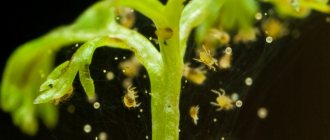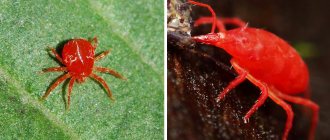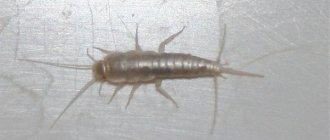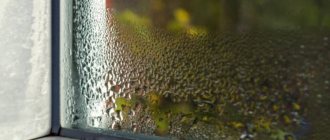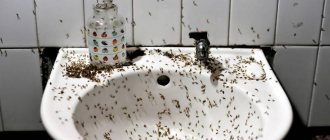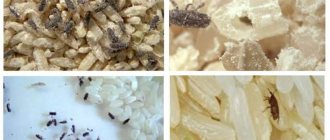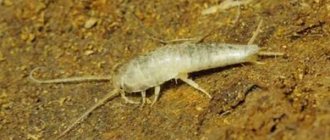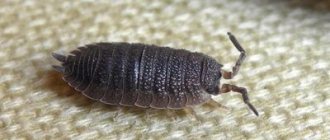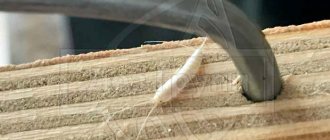Brown bugs
Brown bugs in an apartment live in wardrobes, under baseboards, in food products, they get into carpeting and upholstered furniture, and live on indoor plants. Most often, skin beetles and anthrenuses are found in homes. Caterpillars of leather beetles are very tenacious; unlike adult beetles, they can go without food for several weeks. The larvae hide behind the back walls of cabinets and baseboards, developing first into caterpillars and then into adults.
Insects enter the room through open windows that do not have mesh, through ventilation holes, as well as along with old furniture, cereals, books and spices purchased by weight.
Small bugs in the apartment prefer dry places, as they do not like moisture, so the bathroom is not included in their habitat. Carpet beetles feed on any organic matter, eating skin, fur, fluff, flowers, feathers and food. They love to destroy books whose bindings are glued together with a composition containing starch. The insects reach two to four millimeters in length and are brown, dark brown and black in color.
Varieties of brown bugs
One of the frequent uninvited guests in the apartment is the grain beetle, which loves nuts, cereals, bran, grain and flour. And also the ham skin beetle, which eats any meat and fish products. This bug also destroys stuffed animals, leather goods and furs. Carpet beetles can easily tolerate sudden temperature changes.
They travel from larva to adult in 6 to 12 months. Females of all varieties of these beetles lay more than a hundred eggs, which develop in inconspicuous places. For example, the larvae of brown beetles in an apartment are most often found in dark corners, since they do not tolerate sunlight very well.
Anthrenuses are small pests and reach a size of one to four millimeters and are brown or black in color. They live in carpets and upholstered furniture; they prefer to eat particles of the epidermis and any organic matter. Often cause skin irritation and allergic reactions in humans.
Little black bugs in the apartment
Black bugs get into the apartment in the same ways as brown ones. The main problems when these insects appear in the house are damage to food, furniture, human bites, as well as the rapid reproduction of pests. Some types of black bugs are resistant to various types of infectious diseases. There are quite a few varieties of black bugs.
Let's look at some of them:
- Black cockroaches that reach a length of two to three centimeters. They have a dense black cover. The main danger of these insects is that they are carriers of pathogenic bacteria and viruses, to which they themselves are not susceptible.
- Flour beetle. These insects reach a size of two to four millimeters and are black in color. Such small bugs in the apartment prefer to settle in the kitchen, since their main food is flour, cereals, grains and legumes. They do not pose a danger to humans, but they spoil food.
- Carpet bugs. This species prefers to live in carpeting, bedding and clothing. Usually it is also not dangerous to humans, with the exception of individual cases when an allergic reaction is possible.
Snow Beetle
One of the common pests is the large black beetle in the garden or strigun (kravchik). It is colored black, has a body size of several centimeters, lives in underground burrows and has a hard shell, which is why even birds cannot eat it.
Black earthen beetles usually appear in early spring, cutting off the first shoots of weeds. After the seedlings appear in the garden, pests are taken for them. Striguns are able to quickly destroy all planted seedlings of garden crops, not even disdaining garlic and onions.
To combat the earthen beetle, gardeners use various traditional methods, ranging from manual collection to digging trenches and installing metal profile sheets around the perimeter of the garden.
Usually, at the beginning of June, these long black beetles already finish their destructive activities, burrowing deep underground and laying eggs to provide themselves with offspring. Therefore, only deep digging of the earth in the fall can help destroy pests, during which the larvae that fall to the surface freeze and die.
White bugs
White bugs in an apartment most often live in the bathroom or toilet, as they love damp areas. The most common white bugs that live in our homes are silverfish or woodlice.
The silverfish, when growing, reaches a length of about one centimeter, has an elongated body and a light gray, white or translucent color. It is active at night and moves very quickly with the help of its numerous legs. It feeds on organic food, wet paper, mold, synthetic fibers and dead relatives.
Woodlice also prefer to live in bathrooms and toilets because of their love of moisture. They have a gray, white or brown color, and the body is divided into segments, each of which has a pair of legs. These animals cannot do without water, since they are related to the species of land crustaceans, and their respiration is carried out using gills. They eat any organic substances and are characterized by good fertility. The females of these babies lay about a hundred eggs in an apartment, and after 25 days a fully formed individual appears.
Beneficial bugs in the garden
Some of these small creatures are involved in plant pollination. These are all kinds of bees, butterflies, bumblebees, flies, beetles. Today we will talk about “biological weapons” - beetles that help us fight their harmful brothers. These miniature helpers that protect garden crops, with the right quantity, may well become an alternative to expensive and dangerous chemicals, which are often used to control pests. It has been experimentally proven that with a balanced species composition of arthropods on the site, beetles useful for the garden can destroy up to 40% of harmful beetles. Let's get to know the “rescuers” better, learn how to recognize them externally and attract them to your garden.
Coleoptera
It is this order of insects that are true beetles. Their lower membranous wings, intended for flight, are covered with upper leathery or hard elytra.
Ladybug
These spotted predatory “round” bugs with yellow and red backs are familiar to everyone, even babies, due to their elegant appearance. They are distributed all over the world; in our latitudes alone there are 50-60 species.
Both adult insects and their larvae actively destroy aphids, copperheads, and scale insects in the garden plot. Beetles eat several dozen aphids per day, and larvae eat several hundred aphids! With the end of the warm season, ladybugs hide for the winter under bark or fallen leaves, and in the spring they come out and again begin their useful activities.
Ground beetle
Not all representatives of this large family of beetles are useful for the garden. For example, the ground beetle is an economically important pest.
But in the overwhelming majority, these large, elegant, shiny and fast beetles are precisely the protectors of garden plants, actively eating small slugs, as well as eggs, larvae, pupae and adults of many harmful insects. Thus, a ground beetle is capable of destroying about 100 larvae or 5-10 caterpillars per day, depending on their size.
Flying bugs
Very often there are flying bugs in houses. In most cases it is midges. They are small in size and grow to a length of about three millimeters. The midge does not cause much harm, but it gets into food and drinks, gets into a person’s ears and crawls into the eyes.
Some types of flying bugs in an apartment can bite and also cause the death of plants and flowers in the house. Most often, midges appear in expired products, in stagnant water and in the soil of houseplants oversaturated with water.
Some types of skin beetles and black beetles can also fly around the apartment. From time to time, aphids may appear and feed on the sap of representatives of indoor flora. In addition to discomfort, aphids cause dangerous diseases in plants. It reaches a length of about three millimeters, and only some species are from five to seven millimeters in length. These insects have different colors: green, gray, dark brown and black.
Weevils
Another pest you can often find in the kitchen is the weevil beetle, or, as it is also called, the elephant beetle. These little brown bugs in the apartment are found directly in the products themselves. They got their name because of the peculiarities in the structure of the body. In the front of their head they have a long tube through which weevils feed.
Weevils are one of the largest families of beetles, with eight species found in most cases. The most harmful of them are considered to be grains. These insects cause damage in agriculture, reducing crop yields by 40%. Weevil larvae are omnivorous; they consume the stems and leaves of domestic plants, buds and shoots, as well as cereals, grains and legumes.
Once grain-related weevils have appeared in an apartment, they begin to lay eggs inside plants or fruits, in which the larva subsequently develops. Feeding and destroying its “home”, it turns into a pupa, and then into an adult bug.
Beetles are wood pests
Representatives that damage the bark of trees are also dangerous. They usually live inside trunks and branches, preventing them from fully developing. Let's consider popular representatives.
Bark beetles
Bark beetles (Scolytinae) are parasites whose life takes place inside trees. Even as larvae, they bore tunnels under the bark, making real passages out of the branches, which leads to their drying out. In addition, if there are bark beetles on the trees, there is a high probability that other parasites will attack it.
To prevent the development of these parasites, it is recommended to promptly remove damaged and dry branches and thin out the plantings. You can use baits that are laid out on the territory. If preventive measures do not help, then more serious methods of control will need to be used. These include treatment with the drugs “Confidor Extra”, “Koragen”, “Aktara”, “Topaz”, “Clipper”, “Kartotsid”.
Zlatki
Another widespread beetle pest of fruit crops is the borer ( Buprestidae). Most of the beetles develop on shrub and tree crops. The golden beetles are distinguished by the shiny surface of the elytra, which has various shades.
Types of borers and their larvae
It is a mistake to think that borers feed exclusively on bark. They settle on trees to lay larvae in the bark, and insects can feed on buds, pollen, and leaf blades. Depending on which tree the parasite settles on, even the names of the borers arose - pear, currant, bicolor, grape, smoky.
To fight parasites, use Confidor Extra, Coragen, and also spraying with phosphamide or karbofos (0.2% solution). It is recommended to treat not only leaves, but also trunks and soil under plantings.
Another type of weevil
Another common type of weevil is the rice weevil, which is just as dangerous to food as the grain weevil. It is a brown bug, three to four millimeters long. It has small wings and a lighter color than the granary weevil.
He also eats almost all types of cereals, grains and beans, and even eats tobacco found in cigarettes. In the apartment, rice weevils settle in cracks in the floors and walls and take refuge among old books. The female lays from 150 to 300 eggs. At home, eight to ten generations of these pests can appear per year.
In addition to spoiling food, weevils cause allergic alveolitis in humans. They also pose a great danger to grain storage facilities and flour mills. Grain with weevils that enters food after making baked goods from it can cause serious gastrointestinal diseases in people.
Methods to combat weevils
When small bugs appear in the apartment, it is necessary to urgently take measures to destroy them. If you find a weevil beetle or its pupae in food, you should immediately throw away these products, after carefully packing them in plastic bags. If this pest has not managed to spoil food supplies, you can get rid of it in the following way.
Cereals, legumes and grains in which bugs were found must be placed in a refrigerator, in which, at zero temperature, adults will die in two months, larvae in one month, and egg laying in three weeks. The weevil can be frozen at -15°C and will die within 24 hours.
There is also an option - to bake the food in the oven at a temperature of 60 degrees for 48 hours. You can also use numerous insecticidal products, which are widely available in the retail trade. You should choose exactly the drug that is suitable for your case, in a good price-quality ratio.
Ways to deal with brown bugs
How to get rid of brown bugs in an apartment? First of all, you need to identify all the places where brown bugs live. It is imperative to find the oviposition sites and mechanically destroy them to prevent the proliferation of pests. The next step will be to select the necessary means for removing parasites. It is necessary to select a drug taking into account that there is no allergy to it, since most of these drugs are highly toxic.
Brown bugs in the apartment are also removed using folk remedies and chemicals. The difficulty in fighting this type of insect is that you will have to treat a fairly large amount of territory in your apartment. If you find that there are a great many brown bugs in your home, then it is recommended to call a pest control service. Its representatives will effectively deal with insects in a short time and at a relatively low price for their services.
Unified Sanitary Service and its advantages
As we have already mentioned, you can fight the pest on your own, but in this case you cannot expect guaranteed success.
It’s hard to imagine how much damage the parasite will cause while you poison or freeze it out. It would be much more effective to contact the exterminators of the Unified Sanitary Service. We know first-hand how to get rid of black beetles in an apartment, how to minimize treatment time and damage from it, and how to make sure that pests no longer bother you in the future. Would you like us to share our experience and save you from the annoying “neighborhood”? Then one call: 8(495)2553853 - and our exterminators are on their way! There are a lot of bugs in the apartment. Some live in things, others in products. They can be:
- black;
- brown;
- red.
They differ not only in color - all of them, despite their external similarity, belong to different species and feed differently.
Fighting black bugs
Bugs in the apartment living in carpets can be destroyed very simply. It is enough to take the carpet to the dry cleaner, and after it is treated with special compounds, all the bugs and their egg-laying will die. Wood beetles and leather beetles, which often live in bedding and clothing, can be destroyed by heat treating these items.
But fighting black bugs and cockroaches is quite difficult, since these insects tolerate various types of poisons and insecticides well. Moreover, over time, this type of bug adapts to the poison and develops immunity.
There is also a high probability that after you treat your apartment with special means, some of the bugs will move to the neighbor’s living space, and after some time they will return. It is for this reason that it is recommended to contact an insecticidal service in order to quickly, competently and efficiently deal with uninvited guests.
Description and control of beetles - plant pests that eat tree roots
Such parasites are dangerous because it is quite difficult to recognize their presence on plants, since they damage the root system and not the leaves. We suggest considering the most popular representatives.
Medvedki
Mole crickets (Gryllotalpidae) are large brown insects, which are also often called earthen crayfish. Parasites lead an underground lifestyle, and larvae are also laid there. Due to digging underground tunnels, mole crickets harm the roots by eating them. There are even cases when they can even eat seedlings of plantings, especially young seedlings.
Mole cricket beetle and its offspring
You can fight mole crickets by placing various traps (containers with honey, beer) on the territory. The tunnels where earthen crayfish hide must be shed with infusion of onion or garlic. The use of insecticides is also practiced - “Medvetox”, “Rembek” or “Antimedvedka”. The preparations are placed in holes when planting young trees or seedlings.
Khrushchev or May beetles are plant pests
Khrushchev (Melolonthinae) are another pests of trees and shrubs that feed on their roots. As a result of an attack by beetles, trees begin to develop worse, and young seedlings may die.
To combat beetles, it is best to take an integrated approach. It is popular to install light traps and deep digging of soil where plants can hide. To treat trees, biological insecticides are used, as well as chemical preparations - “Zemlin”, “Antikhrushch”, “Bazudin”.
Removal of flying bugs and prevention
Flying bugs in an apartment will cause much less trouble compared to black bugs. Midges or aphids can be easily removed using insecticidal sprays and powders. They are very sensitive to chemicals and cannot resist them. It will be enough just to choose a means for their destruction from the assortment available in specialized stores.
It is also important to search your apartment for the presence of a clutch of midge or aphid eggs, and if found, destroy it mechanically, and treat the location of the insects with a pest control compound. After baiting small bugs in the apartment, it is necessary to do a damp general cleaning and ventilate the room well.
An important aspect in the fight against insects that have settled in your apartment is prevention. It is necessary to periodically sort out the products in the kitchen, especially cereals, legumes and grains. Browse carpeting, bedding and clothing. Pay attention to secluded places in the bathroom and toilet. If bugs appear again in the apartment, then it is necessary to immediately take measures to combat them.
In order to prevent the appearance of insects in the apartment, it is also necessary to cool the room in winter. When the outside temperature is minus 10 degrees, open the windows wide for at least four hours, leaving the room yourself during this time. The procedure is recommended to be carried out once a month. This will help prevent various pests from appearing in your apartment.
It is necessary to maintain cleanliness and order in the home, once a month to do wet cleaning with pest control agents. Keep clothes and bedding in the sun in the summer, and freeze them outside in the winter. This will help prevent the appearance of bugs and destroy them if they are present on things. By following these recommendations, you can effectively combat insects that have appeared in your apartment, as well as prevent their reappearance along with the problems they cause.
melon aphid
Numerous scatterings of tiny green or black aphids can destroy many plantings of vegetable and berry crops.
Aphids settle in colonies. Feeding exclusively on plant sap, which they suck from young shoots, they poison plants with injected poison and can carry infections and viruses. In the absence of timely measures to destroy aphids, they can completely destroy most of the crop.
Methods for controlling aphids are carried out in several ways:
